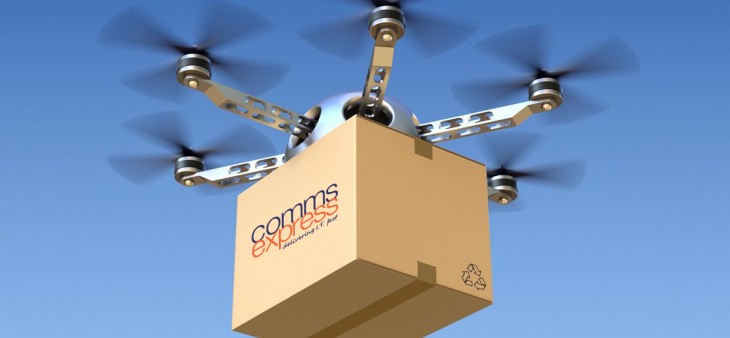
Here at Comms our tagline is ‘delivering IT fast’. It’s a tagline we pride ourselves on justifying. Many of the reviews we kindly receive – and we read every one of them! – make a point of mentioning how pleasing it is to receive the goods ordered promptly.
Our preferred delivery method is via the Royal Mail or a courier service, such as DPD, and very happy we are too.
However how far are we from a world whereby a drone is the preferred method of delivery? If reports are to be believed some are predicting within a year whereas others are more cautious.
Our friends at Amazon over in the US would like to see Congress agree to a bill that would see packages delivered by Drones within 30 minutes of ordering within a year. If this is to become a reality the FAA regulations needed to change before the service can launch.
So if governments change regulations to align with emerging technologies would we see a sky full of drones?
Worryingly statistics show that the FAA receive 25 reports a month from pilots and others of drones flying in the vicinity of planes and airports, raising concerns about the potential for collisions. Recently an off-duty intelligence officer flew a drone onto the grounds of the White House — highlighting just how easy it is for drones to navigate seemingly secure locations.
The Guardian have reported that Professor Sajiv Singh of Carnegie Mellon University robotics institute, who runs a “critical cargo delivery” company called NearEarth said that piloting a state-of-the-art drone was a little more like leaving it a trail of breadcrumbs: go to this altitude, perform this short task, go back home. But even short flights from a mobile landing pad pose serious logistical problems, he said.
“They’re not proposing to deliver from one uninhabited place to another uninhabited place; they’re proposing to deliver from a warehouse to where the consumer is, which is likely an urban area or a suburban area,” he said. “In those particular cases, there are going to be hazards along the way that the vehicle is going to have to detect. Maybe there will be terrain that the map doesn’t know about, unless you’ve mapped that exact route before. Even then, maybe there’s construction equipment that wasn’t there but is there now. Maybe GPS signals are blocked or partially blocked in which case it’s going to have an incorrect idea about where it is.” All this is surmountable, he said – but it’s difficult.”
So what of the Amazon drones themselves, how exactly do they work? Well the patent that has just been approved details that the drones will be able to track the location of the person it is delivering to by pulling data from their smartphone.
The unmanned vehicles will also be able to talk to each other about weather and traffic conditions. Back in March FAA granted it permission to start testing in the US, although the drones can fly no higher than 400ft (122m) and must remain within the pilot’s line of sight.
How long before we see drones delivering goods in the sky above us in the UK remains to be seen. However we most certainly look forward to hearing more on this subject, it’s certainly makes for an interesting future!
Until next time…
